Formula C4H8O2 Molar mass 88.11 g/mol Density 960 kg/m³ Appearance Colorless liquid | IUPAC ID Butanoic acid Boiling point 163.5 °C Melting point -7.9 °C | |
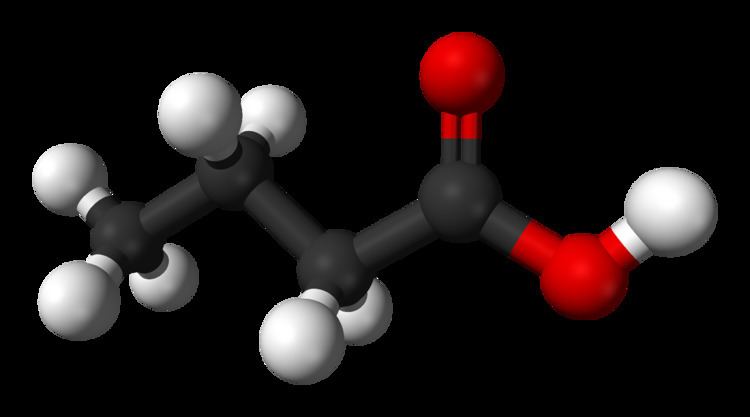 | ||
Related compounds | ||
How to make butyric acid smell of vomit oxidation method
Butyric acid (from Greek βούτῡρον, meaning "butter"), also known under the systematic name butanoic acid, abbreviated BTA, is a carboxylic acid with the structural formula CH3CH2CH2-COOH. Salts and esters of butyric acid are known as butyrates or butanoates. Butyric acid is found in milk, especially goat, sheep and buffalo milk, butter, parmesan cheese, and as a product of anaerobic fermentation (including in the colon and as body odor). It is also found in milk chocolate produced by the Hershey process, or added to imitate the flavour of Hershey's chocolate. Butyric acid is present in, and is the main distinctive smell of, human vomit. It has an unpleasant smell and acrid taste, with a sweetish aftertaste similar to ether. Mammals with good scent detection abilities, such as dogs, can detect it at 10 parts per billion, whereas humans can detect it in concentrations above 10 parts per million.
Contents
- How to make butyric acid smell of vomit oxidation method
- Htm butyric acid
- Chemistry
- Safety
- Production
- Uses
- Biosynthesis
- Pharmacodynamics
- Pharmacokinetics
- Metabolism
- Peripheral therapeutic effects
- Immunomodulation and inflammation
- Cancer
- Diabetes
- Addiction
- Cognitive deficits and memory
- References
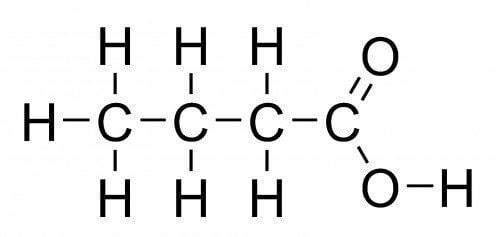
Butyric acid was first observed in impure form in 1814 by the French chemist Michel Eugène Chevreul. By 1818, he had purified it sufficiently to characterize it. However, Chevreul did not publish his early research on butyric acid; instead, he deposited his findings in manuscript form with the secretary of the Academy of Sciences in Paris, France. Henri Braconnot, a French chemist, was also researching the composition of butter and was publishing his findings, and this led to disputes about priority. As early as 1815, Chevreul claimed that he had found the substance responsible for the smell of butter. By 1817, he published some of his findings regarding the properties of butyric acid and named it. However, it was not until 1823 that he presented the properties of butyric acid in detail. The name of butyric acid comes from the Latin word for butter, butyrum (or buturum), the substance in which butyric acid was first found.
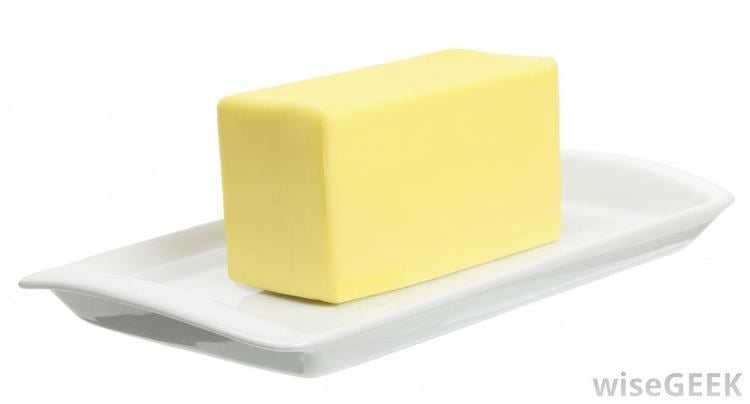
Htm butyric acid
Chemistry
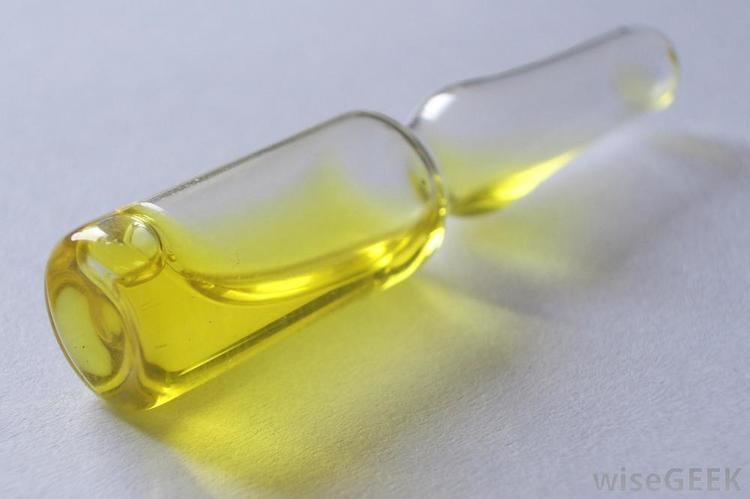
Butyric acid is a fatty acid occurring in the form of esters in animal fats. The triglyceride of butyric acid makes up 3–4% of butter. When butter goes rancid, butyric acid is liberated from the glyceride by hydrolysis, leading to the unpleasant odor. It is an important member of the fatty acid subgroup called short-chain fatty acids. Butyric acid is a medium-strong acid that reacts with bases and strong oxidants, and attacks many metals.

The acid is an oily, colorless liquid that is easily soluble in water, ethanol, and ether, and can be separated from an aqueous phase by saturation with salts such as calcium chloride. It is oxidized to carbon dioxide and acetic acid using potassium dichromate and sulfuric acid, while alkaline potassium permanganate oxidizes it to carbon dioxide. The calcium salt, Ca(C4H7O2)2·H2O, is less soluble in hot water than in cold.
Butyric acid has a structural isomer called isobutyric acid (2-methylpropanoic acid).
Safety

Personal protective equipment such as rubber or PVC gloves, protective eye goggles, and chemical-resistant clothing and shoes are used to minimize risks when handling butyric acid.
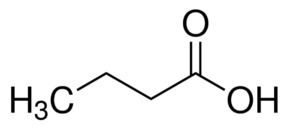
Inhalation of butyric acid may result in soreness of throat, coughing, a burning sensation, and laboured breathing. Ingestion of the acid may result in abdominal pain, shock, and collapse. Physical exposure to the acid may result in pain, blistering and skin burns, while exposure to the eyes may result in pain, severe deep burns and loss of vision.
Production
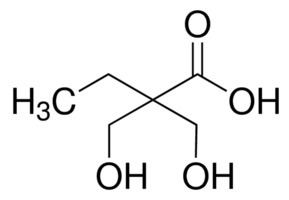
It is industrially prepared by the fermentation of sugar or starch, brought about by the addition of putrefying cheese, with calcium carbonate added to neutralize the acids formed in the process. The butyric fermentation of starch is aided by the direct addition of Bacillus subtilis. Salts and esters of the acid are called butyrates or butanoates.
Butyric acid or fermentation butyric acid is also found as a hexyl ester hexyl butyrate in the oil of Heracleum giganteum (a type of hogweed) and as the octyl ester octyl butyrate in parsnip (Pastinaca sativa); it has also been noticed in skin flora and perspiration.
Uses
Butyric acid is used in the preparation of various butyrate esters. Low-molecular-weight esters of butyric acid, such as methyl butyrate, have mostly pleasant aromas or tastes. As a consequence, they are used as food and perfume additives. It is also used as an animal feed supplement due to the ability to reduce pathogenic bacterial colonization. It is an approved food flavoring in the EU FLAVIS database (number 08.005).
Due to its powerful odor, it has also been used as a fishing bait additive. Many of the commercially available flavors used in carp (Cyprinus carpio) baits use butyric acid as their ester base; however, it is not clear whether fish are attracted by the butyric acid itself or the substances added to it. Butyric acid was, however, one of the few organic acids shown to be palatable for both tench and bitterling.
The substance has also been used as a stink bomb by Sea Shepherd Conservation Society to disrupt Japanese whaling crews, as well as by anti-abortion protesters to disrupt abortion clinics.
Biosynthesis
Butyrate is produced as end-product of a fermentation process solely performed by obligate anaerobic bacteria. Fermented Kombucha "tea" includes butyric acid as a result of the fermentation. This fermentation pathway was discovered by Louis Pasteur in 1861. Examples of butyrate-producing species of bacteria:
The pathway starts with the glycolytic cleavage of glucose to two molecules of pyruvate, as happens in most organisms. Pyruvate is then oxidized into acetyl coenzyme A using a unique mechanism that involves an enzyme system called pyruvate:ferredoxin oxidoreductase. Two molecules of carbon dioxide (CO2) and two molecules of elemental hydrogen (H2) are formed as waste products from the cell. Then,
ATP is produced, as can be seen, in the last step of the fermentation. Three molecules of ATP are produced for each glucose molecule, a relatively high yield. The balanced equation for this fermentation is
C6H12O6 → C4H8O2 + 2 CO2 + 2 H2Several species form acetone and n-butanol in an alternative pathway, which starts as butyrate fermentation. Some of these species are:
These bacteria begin with butyrate fermentation, as described above, but, when the pH drops below 5, they switch into butanol and acetone production to prevent further lowering of the pH. Two molecules of butanol are formed for each molecule of acetone.
The change in the pathway occurs after acetoacetyl CoA formation. This intermediate then takes two possible pathways:
Highly-fermentable fiber residues, such as those from resistant starch, oat bran, pectin, and guar are transformed by colonic bacteria into short-chain fatty acids (SCFA) including butyrate, producing more SCFA than less fermentable fibers such as celluloses. One study found that resistant starch consistently produces more butyrate than other types of dietary fiber. The production of SCFA from fibers in ruminant animals such as cattle is responsible for the butyrate content of milk and butter.
Fructans are another source of prebiotic soluble dietary fibers. They are often found in the soluble fibers of foods which are high in sulfur, such as the Allium and Cruciferous vegetables. Sources of fructans include wheat (although some wheat strains such as spelt contain lower amounts), rye, barley, onion, garlic, Jerusalem and globe artichoke, asparagus, beetroot, chicory, dandelion leaves, leek, radicchio, the white part of spring onion, broccoli, brussels sprouts, cabbage, fennel and prebiotics such as fructooligosaccharides (FOS), oligofructose and inulin. While many of these foods lack in butyrate production compared to resistant starch, they do have a number of benefits. They generally possess a low glycemic index which appeals well to diabetics. They also appeal to those on the ketogenic diet who benefit from beta-hydroxybutyric acid, which is a HDAC inhibitor which can cross the blood brain barrier and be used as fuel in the mitochondria of brain cells. Other HDAC inhibitors in these butyrate producing foods are sulforaphane, which has promise in inhibiting human breast cancer cells. Sulforaphane has also been shown to promote hair growth in mice, it contains compounds which prevent ulcers, and helps with cognitive function in rats. It is good to note that sulforaphane in broccoli is destroyed if prepared improperly. Diallyl disulfide found in the fructans containing garlic has been shown to reduce chemical toxicity and carcinogenesis in rodents, and shows synergestic benefits with butyrate when it comes to inhibiting the growth of human cancer tumor cells in the colon.
Pharmacodynamics
Like other short-chain fatty acids (SCFAs), butyrate is an agonist at the free fatty acid receptors FFAR2 and FFAR3, which function as nutrient sensors which help regulate energy balance; unlike the other SCFAs, butyrate is also an agonist of niacin receptor 1 (NIACR1, aka GPR109A). Butyric acid is utilized by mitochondria, particularly in colonocytes and by the liver, to generate adenosine triphosphate (ATP) during fatty acid metabolism. Butyric acid is also an HDAC inhibitor (specifically, HDAC1, HDAC2, HDAC3, and HDAC8), a drug that inhibits the function of histone deacetylase enzymes, thereby favoring an acetylated state of histones in cells. Histone acetylation loosens the structure of chromatin by reducing the electrostatic attraction between histones and DNA. In general, it is thought that transcription factors will be unable to access regions where histones are tightly associated with DNA (i.e., non-acetylated, e.g., heterochromatin). Therefore, butyric acid is thought to enhance the transcriptional activity at promoters, which are typically silenced or downregulated due to histone deacetylase activity.
Pharmacokinetics
Butyrate that is produced in the colon through microbial fermentation of dietary fiber is primarily absorbed and utilized by colonocytes and the liver for the generation of ATP during energy metabolism; however, some butyrate is absorbed in the distal colon, which is not connected to the portal vein, thereby allowing for the systemic distribution of butyrate to multiple organ systems through the circulatory system. Butyrate that has reached systemic circulation can readily cross the blood-brain barrier via monocarboxylate transporters (i.e., certain members of the SLC16A group of transporters). Other transporters that mediate the passage of butyrate across lipid membranes include SLC5A8 (SMCT1), SLC27A1 (FATP1), and SLC27A4 (FATP4).
Metabolism
Butyric acid is metabolized by various human XM-ligases (ACSM1, ACSM2B, ASCM3, ACSM4, ACSM5, and ACSM6), also known as butyrate–CoA ligase. The metabolite produced by this reaction is butyryl–CoA, and is produced as follows:
Adenosine triphosphate + Butyric acid + Coenzyme A → Adenosine monophosphate + Pyrophosphate + Butyryl-CoAAs a short-chain fatty acid, butyrate is utilized by mitochondria as an energy (i.e., adenosine triphosphate or ATP) source through fatty acid metabolism.
In humans, the butyrate prodrug tributyrin is metabolized by triacylglycerol lipase into dibutyrin and butyrate through the reaction:
Tributyrin + H20 = Dibutyrin + ButyratePeripheral therapeutic effects
Butyrate has numerous beneficial effects in humans on energy homeostasis and related diseases (diabetes and obesity), inflammation, and immune function (e.g., it has pronounced antimicrobial and anticarcinogenic effects). These effects occur through its utilization by mitochondria to generate ATP during fatty acid metabolism or through one or more of its histone-modifying enzyme targets (i.e., the class I histone deacetylases) and G-protein coupled receptor targets (i.e., FFAR2, FFAR3, and NIACR1).
Immunomodulation and inflammation
Butyrate's effects on the immune system are mediated through the inhibition of class I histone deacetylases and activation of its G-protein coupled receptor targets: NIACR1 (GPR109A), FFAR2 (GPR43), and FFAR3 (GPR41). Among the short-chain fatty acids, butyrate is the most potent promoter of intestinal regulatory T cells in vitro and the only one among the group that is an NIACR1 ligand. It has been shown to be a critical mediator of the colonic inflammatory response. It possesses both preventive and therapeutic potential to counteract inflammation-mediated ulcerative colitis and colorectal cancer.
Butyrate has established antimicrobial properties in humans that are mediated through the antimicrobial peptide LL-37, which it induces via HDAC inhibition on histone H3. Butyrate increases gene expression of FOXP3 (the transcription regulator for Tregs) and promotes colonic regulatory T cells (Tregs) through the inhibition of class I histone deacetylases; through these actions, it increases the expression of interleukin 10, an anti-inflammatory cytokine. Butyrate also suppresses colonic inflammation by inhibiting the IFN-γ–STAT1 signaling pathways, which is mediated partially through histone deacetylase inhibition. While transient IFN-γ signaling is generally associated with normal host immune response, chronic IFN-γ signaling is often associated with chronic inflammation. It has been shown that butyrate inhibits activity of HDAC1 that is bound to the Fas gene promoter in T cells, resulting in hyperacetylation of the Fas promoter and up-regulation of Fas receptor on the T-cell surface. It is thus suggested that butyrate enhances apoptosis of T cells in the colonic tissue and thereby eliminates the source of inflammation (IFN-γ production).
Similar to other NIACR1 agonists, butyrate also produces marked anti-inflammatory effects in a variety of tissues, including the brain, gastrointestinal tract, skin, and vascular tissue. Butyrate binding at FFAR3 induces neuropeptide Y release and promotes the functional homeostasis of colonic mucosa and the enteric immune system.
Butyric acid is important as an energy (ATP) source for cells lining the mammalian colon (colonocytes). Without butyric acid for energy, colon cells undergo upregulated autophagy (i.e., self-digestion).
Cancer
Butyrate produces different effects in healthy and cancerous cells; this is known as the "butyrate paradox". In particular, butyrate inhibits colonic tumor cells and promotes healthy colonic epithelial cells. The signaling mechanism is not well understood. A review suggested that the chemopreventive benefits of butyrate depend in part on the amount, time of exposure with respect to the tumorigenic process, and type of fat in the diet. The production of volatile fatty acids such as butyrate from fermentable fibers may contribute to the role of dietary fiber in colon cancer. Short-chain fatty acids, which include butyric acid, are produced by beneficial colonic bacteria (probiotics) that feed on, or ferment prebiotics, which are plant products that contain adequate amounts of dietary fiber. These short-chain fatty acids benefit the colonocytes by increasing energy production and cell proliferation, and may protect against colon cancer.
Conversely, some researchers have sought to eliminate butyrate and consider it a potential cancer driver. Studies in mice indicate it drives transformation of MSH2-deficient colon epithelial cells. It is important to note that these are related to a gene deficiency. Niacin, beta-hydroxybutyrate, and curcumin may be effective adjunct treatments if genetic issues are present.
Diabetes
A review on the relationship between the microbiome and diabetes asserted that butyrate can induce "profound immunometabolic effects" in animal models and humans with type 2 diabetes; it also noted a relationship between the presence of obesity or diabetes and a state of marked dysbiosis in a host, which is not yet completely understood. While acknowledging that there is strong evidence for the use of butyrate in such disorders, the review called for more research into the pathophysiology (i.e., biomolecular mechanisms) of these diseases, so as to improve therapeutic approaches to these diseases.
Addiction
The observation of a large number of downregulated genes after methamphetamine withdrawal is consistent with previous results showing that methamphetamine can cause increased expression of histone deacetylases (HDACs) in the nucleus accumbens and the dorsal striatum. Butyric acid is a HDAC inhibitor. HDACs are enzymes that can cause histone deacetylation and repression of gene expression. HDACs are important regulators of synaptic formation, synaptic plasticity, and long-term memory formation. Several HDACs also appear to play significant roles in various models of drug abuse and addiction. The local knockout of HDAC1, as well as chronic and continuous infusion of MS-275, a pharmacological inhibitor highly selective in vitro for HDAC1, has been found with NAc suppressed cocaine-induced locomotor sensitization in mice. HDAC3 inhibitor RGFP966 has been shown to facilitate the extinction of cocaine-seeking behavior and prevent reinstatement of cocaine-conditioned place preference in mice. Histone deacetylase inhibitors have been shown to decrease cocaine, but not sucrose, self-administration in rats. The beneficial bacteria that ferment probiotics and prebiotics to produce butyric acid have been shown to regulate behavior by means of the vagus nerve.
Cognitive deficits and memory
Studies in rodents have found that the environment exerts an influence on epigenetic changes related to cognition, in terms of learning and memory; environmental enrichment is correlated with increased histone acetylation, and verification by administering histone deacetylase inhibitors induced the sprouting of dendrites, an increased number of synapses, and reinstated learning behaviour and access to long-term memories. Research has also linked learning and long-term memory formation to reversible epigenetic changes in the hippocampus and cortex in animals with normal-functioning, undamaged brains. In human studies, post-mortem brains from Alzheimer's patients show increased histone de-acetylase levels.
